When it comes to bow hunting, one of the most critical aspects of your gear is your choice of a good boot. The right pair of boots can provide you comfort, support, and protection during long hours spent in various hunting environments. As a bowhunter, it’s important to understand the different options available and to choose the best hunting boots that suit your unique needs and preferences.

There are several factors to consider when selecting the ideal pair of bow hunting boots, such as the materials used, the type of terrain you’ll be encountering, and the level of insulation or waterproofing necessary. Rubber, leather, and fabric are common materials used in hunting boots, each offering distinct advantages and disadvantages based on your specific hunting conditions.
Some of the top bow hunting boots in 2023 include the Kenetrek Corrie 3.2 Hiker for men, DSG Women’s Insulated Rubber Boots for women, and Irish Setter Vaprtrek for lightweight options according to Field and Stream. Understanding your specific needs and the benefits of each option will help guide you in your search for the perfect pair of bow hunting boots to support you during your Elk hunt.
Essential Features in Bow Hunting Boots
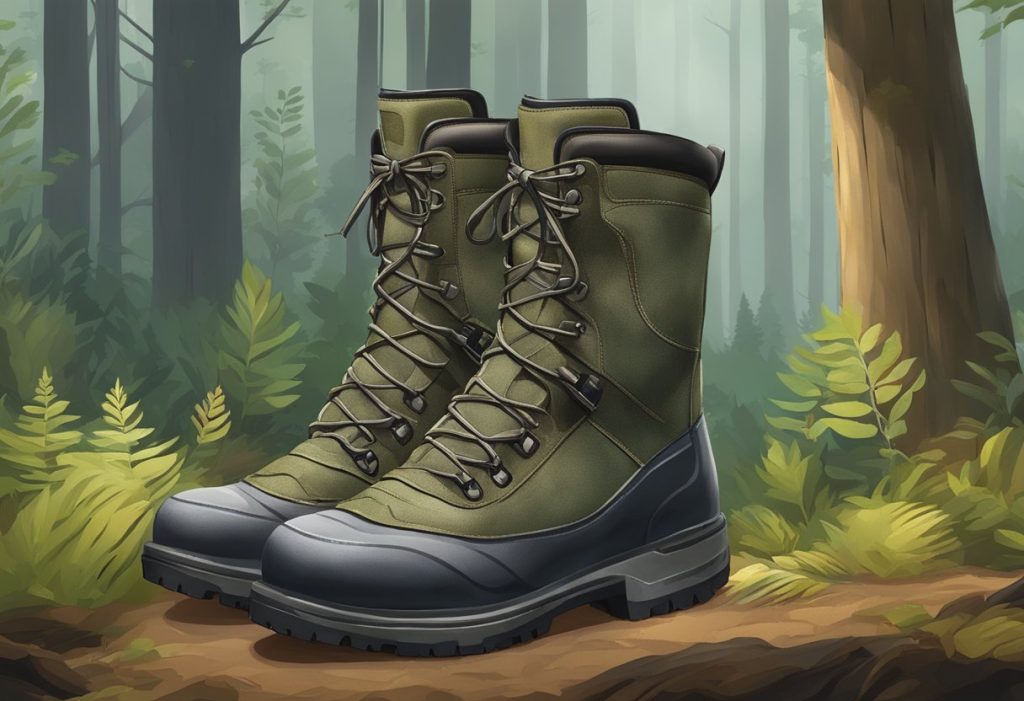
Material Considerations: Nylon, Neoprene, and Leather
When selecting the perfect pair of hunting boots, the materials used in their construction play a vital role. The three primary materials on the market today used in hunting boots are nylon, neoprene, and leather. Each has its own advantages and applications.
Nylon is lightweight, breathable, and dries quickly. Boots made from nylon offer a balance of durability and comfort. They’re the best option for early season hunts and for those who prefer a lighter boot.
Neoprene, on the other hand, offers more insulation, making it ideal for cold feet or wet environments. These most comfortable boots are typically waterproof and offer some level of flexibility. If you frequently hunt in marshy terrain or during the late-season hunts, neoprene boots could be an suitable choice.
Leather boots are known for their durability, support, and classic appearance. They can be more expensive than their nylon or neoprene counterparts, but with proper care, can last for years. Leather boots can be used in a variety of hunting scenarios and are highly adaptable to your needs.
Weather Adaptability: Waterproofness and Thinsulate Insulation
Regardless of the material you choose, your hunting boots should offer weather adaptability features like a waterproof membrane and Thinsulate insulation.
A waterproof membrane can be crucial in keeping your wet feet dry and comfortable during wet or damp conditions. It’s essential to have a boot with a waterproof membrane, such as a Gore-Tex liner, to prevent water from entering and ensure breathability.
In colder environments, having sufficient insulation is vital. Thinsulate, a synthetic fiber insulation, can be found in various amounts in hunting boots. Insulation ratings range from 200g to 1000g or higher. The higher the number, the more insulation is provided. When choosing your boot, consider the temperature and conditions you’ll typically encounter during your hunts.
Remember, the right pair of boots can make a difference in your hunting experience. Take into account your primary hunting situations and conditions, and choose a boot that best suits your needs. With the right material and weather adaptability features, you’ll be well on your way to a successful and comfortable bow hunting adventure.
Top Picks for Durability and Comfort
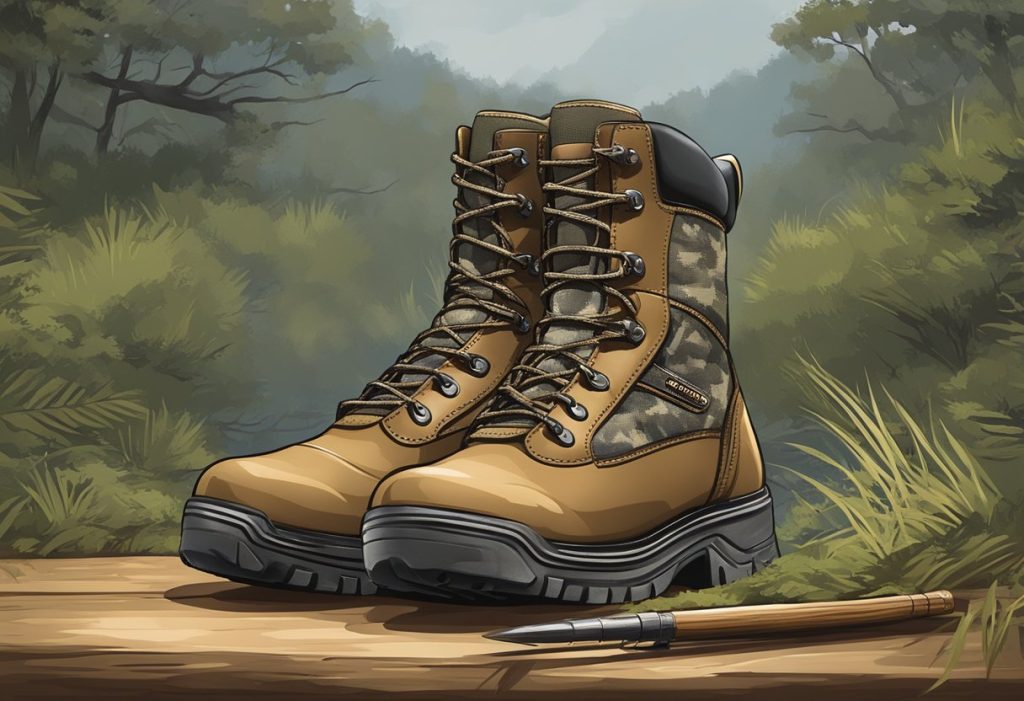
Danner Pronghorn and Kenetrek Mountain Extreme Review
The Danner Pronghorn is a popular choice for bow hunters seeking durability and comfort. Designed with a mix of full-grain leather and 1000 Denier nylon, this boot offers excellent support and protection. The Gore-Tex lining ensures your feet stay dry, while the Cordura material provides additional resistance to abrasions.
When it comes to comfort, the Pronghorn features a cushioning Ortholite footbed and a dual-density midsole, giving you the support and shock absorption needed during long hunts. Their lightweight design also helps reduce fatigue while trekking through rough terrain.
Another top pick for durability and comfort is the Kenetrek Mountain Extreme. This sturdy boot is built with premium 2.8mm full-grain leather and features a rubber sole for excellent grip on various surfaces. It, too, comes with a Gore-Tex membrane which guarantees waterproof protection and breathability.
Kenetrek boots provide exceptional support, thanks to their reinforced toe and heel guards and a 7mm Nylon midsole. Their custom K-Talon outsole ensures stable footing, making them an ideal choice for challenging terrains.
Irish Setter Vaprtrek and Wingshooter Insights
If you’re looking for a lightweight option, the Irish Setter Vaprtrek is worth considering. Weighing 40% less than traditional hunting boots, Vaprtrek boots employ RPM technology to reduce their weight without sacrificing durability. A Gore-Tex membrane, again, keeps your feet dry and comfortable throughout your hunting excursion.
The Vaprtrek’s UltraDry waterproofing system and ScentBan technology work together to keep your feet odor-free, which is a great advantage when hunting. Additionally, its Armatec heel and toe protection prolong the boots’ lifespan.
Another option from Irish Setter is the Wingshooter. This boot focuses on comfort, incorporating a cushioned, moisture-wicking memory foam footbed and EVA midsole. The Goodyear welt construction ensures excellent stability and support while allowing the boot to comfortably conform to your foot.
In terms of protection, the Wingshooter features full-grain leather and UltraDry waterproof technology, which combine to keep your feet dry and protected all day. For long hunts or early morning treks, you can rely on these boots to withstand the elements and provide you with maximum comfort.
Specialized Boots for Varied Terrain
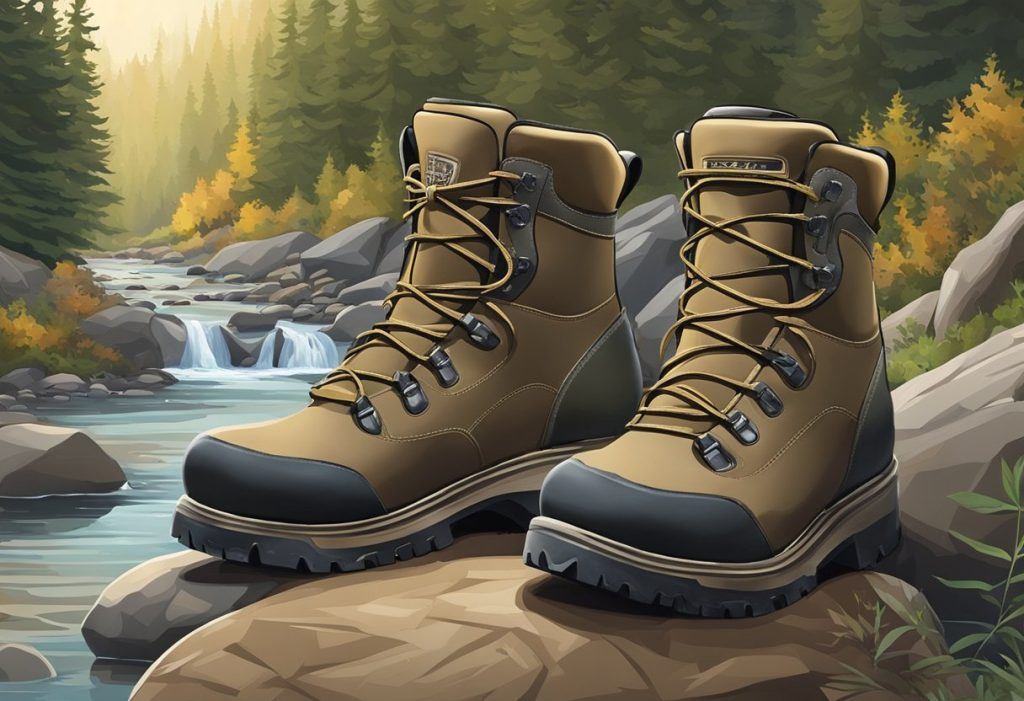
Bow hunting in varied terrain requires specialized footwear to ensure comfort, safety, and performance. The right boot will depend on the type of environment you’ll be hunting in, such as wetlands, brushy terrains, or mountainous landscapes.
Let’s explore the different options available to you.
Rubber Boots for Wetlands: Bogs Blaze II and LaCrosse
When hunting in wetlands or marshy areas, rubber boots are an essential piece of gear. These waterproof boots offer excellent protection from moisture and have good traction for navigating slippery surfaces. Two popular options are the Bogs Blaze II and LaCrosse boots.
Both boast sturdy construction and reliable performance in wet conditions.
- Bogs Blaze II: These boots feature a neoprene upper, ensuring flexibility and temperature regulation in cold weather. Their self-cleaning outsole prevents mud and debris buildup.
- LaCrosse: Known for their durability and slip-resistant soles, these boots have a convenient pull-on style for easy wear and removal.
Snake Boots for Brushy Terrains
When you’re hunting in areas with tall grass or brush, snake boots provide an added layer of protection for your lower legs. These boots have a high, puncture-resistant shaft that protects against snake bites and other hazards. In addition, these boots feature added ankle support and a Brown Vibram outsole for excellent traction in challenging terrain.
Tip: Choose snake boots with reliable closures, such as zippers and straps, to ensure they stay securely in place and prevent potential accidents.
Mountain Hunting Footwear: Grip and Stability
For those who prefer hunting in the steep mountains, a reliable pair of boots with a strong grip is crucial. A good option is the Kenetrek Mountain Extremes, which features a full-grain leather upper, double and triple stitching, and a protective rand.
These boots come with a Vibram outsole, which is known for durability, slip resistance, and traction on rugged terrain. Mountain hunting footwear should also offer ankle support and stability for navigating steep terrain. The Kenetrek Mountain Extreme boots, for instance, are lightweight boots and flexible, making them suitable for whitetail hunters who prioritize agility and comfort.
Innovations in Boot Technology
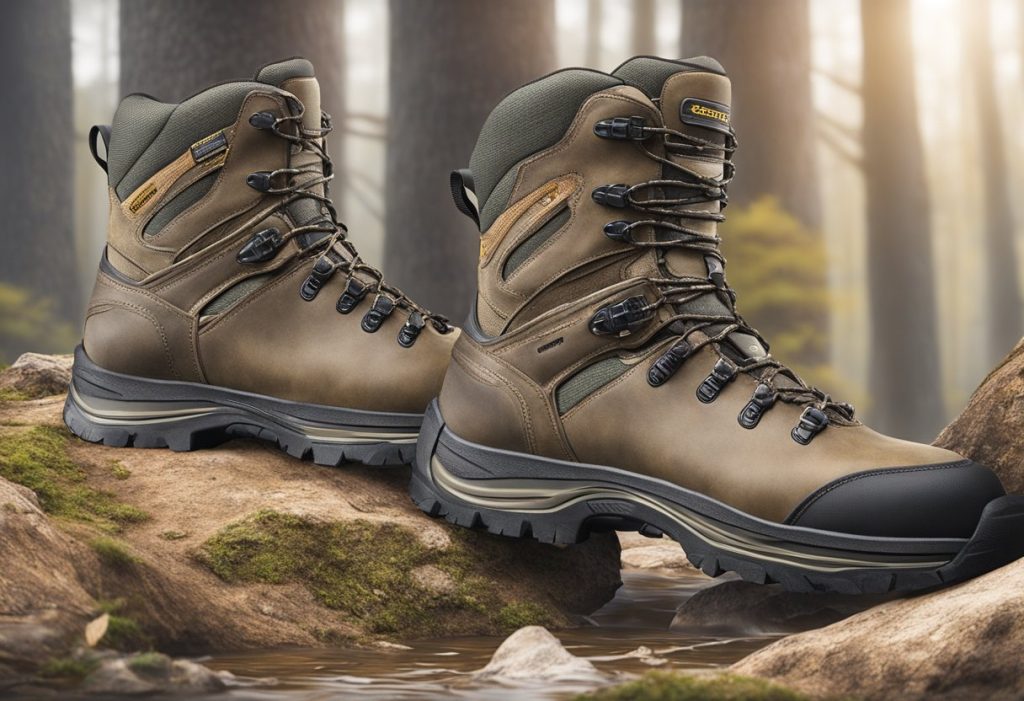
Advancements in Outsoles: SPE Midsole and Vibram
Recent innovations in the boot technology have improved the performance of bow hunting boots significantly. One such advancement is the introduction of the SPE midsole. The SPE midsole is engineered to provide superior comfort, support, and durability. This technology offers excellent cushioning and shock absorption to help prevent foot fatigue during long hunts. With SPE midsole, your hunting experience is likely to be more comfortable than ever before.
Another significant innovation in outsoles is the use of Vibram soles. These soles are widely known for their exceptional durability, flexibility, and traction on various terrains. Vibram soles are designed to provide you with excellent grip, stability, and support, even on slippery surfaces. Combining SPE midsole with Vibram outsoles has resulted in some high-quality hunting boots that can withstand the challenges faced during bow hunting.
Boot Insulation Upgrades: 3M Thinsulate and Fleece Lining
Keeping your feet warm and dry during bow hunting is crucial. That’s where advancements in insulation technologies come in. One such innovation is the 3M Thinsulate insulation, which offers warmth without adding unnecessary bulk to the boots. Thinsulate insulation efficiently traps your body heat, ensuring you warm feet in the cold weather conditions. The material adjusts according to the temperature, making sure your feet remain comfortable throughout the hunt.
Another impressive upgrade in boot insulation is the use of fleece lining. Fleece provides excellent thermal insulation, and its soft texture offers added comfort to your feet. Boots featuring fleece lining are not only warm but also moisture-wicking, ensuring your feet stay dry during your hunting adventures.
To summarize, innovations in boot technology, such as SPE midsole and Vibram outsoles, have significantly improved the performance and comfort of bow hunting boots. Upgrades in insulation, like 3M Thinsulate and fleece lining, ensure your feet stay warm and dry even in extreme weather conditions. These advancements are significant contributors to the overall satisfaction of western hunters. Next time you go on a hunt, look for these features in your hunting boots to enhance your experience.
Considerations for Weather and Season
When choosing the best bow hunting boots, it’s essential to consider the weather and season in which you will be hunting. Different climate conditions demand different features to ensure optimal performance and comfort. In this article, we will discuss waterproof and insulated options for cold climates and breathability and cooling features for warm weather.
Waterproof and Insulated Options for Cold Climates
In cold climates, it’s crucial to have weather-proof boots that protect your feet from cold temperatures and wet conditions. Look for hunting boots with a proper waterproof lining, such as GORE-TEX, to keep your feet dry in snow or rain.
Insulation is another essential feature for hunting boots in cold climates. Opt for boots with 400 to 600 grams of insulation to ensure warmth. You can fine-tune the insulation by wearing thicker or thinner wool socks, depending on the temperature and your level of activity. Gaiters are also worth considering, as they help keep your feet and legs clean, dry, and warm when trudging through deep snow or dew-covered vegetation.
Breathability and Cooling Features for Warm Weather
When hunting in warm weather, your priority should be to find boots that offer excellent breathability and remain comfortable in hot conditions. Non-insulated, all-leather hiking boots are a versatile option for these purposes, as they are suitable for various terrains and provide adequate protection against thorns and sharp rocks.
Look for boots that feature moisture-wicking linings and ventilation panels to help keep your feet dry and cool during long hours of walking in the heat. Additionally, go for boots with a removable footbed, as this allows for easier cleaning and drying, ensuring that your boots remain fresh and odor-free.
By carefully considering the weather and season in which you will be hunting, you can select the ideal bow hunting boots that cater to your specific needs. With the right boots, you can confidently pursue your prey and focus on the thrill of the hunt, knowing that your feet will remain comfortable and protected in any environment.
Boot Maintenance and Longevity
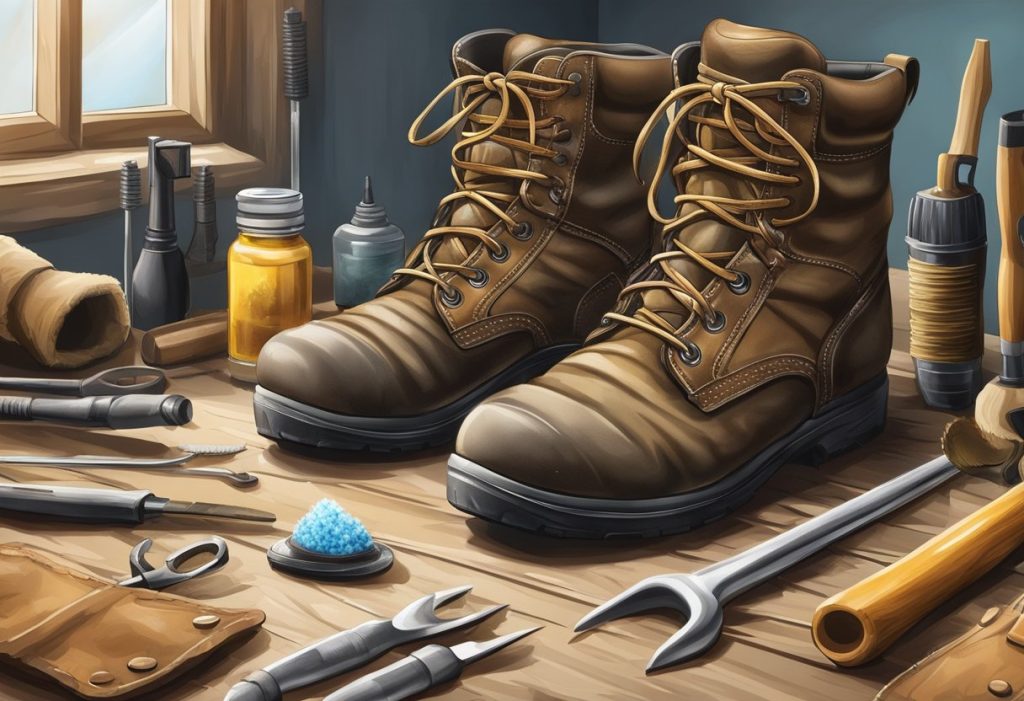
Cleaning Techniques and Storage Tips
Proper cleaning and storage of your bow hunting boots are essential for maintaining their durability and performance. First, remove any dirt and mud stuck on the boots with a stiff-bristle brush. For a deeper clean, mix mild soap and water to create a cleaning solution and gently scrub your boots. Once cleaned, it’s crucial to let your boots air-dry in a cool and well-ventilated area, away from direct sunlight or heat sources, as excessive heat can damage the materials.
Store your boots in a cool, dry place when not in use to prevent the growth of mold and mildew. Storing them away from direct sunlight and heat sources will further preserve the integrity of the materials. If possible, use a boot dryer and cedar shoe trees to help maintain their shape and absorb any residual moisture.
Reinforced Stitching and Material Longevity
Reinforced double and triple stitching plays an essential role in your bow hunting boots’ durability. This stitching technique enhances the overall construction, ensuring a well-structured, robust, and resistant boot ready to face multiple hunting adventures. Reinforced stitching is typically found in high-stress and high-abrasion areas, such as the toe cap and heel counter.
Material longevity and quality are key factors in hunting boots’ durability. When selecting your boots, opt for those made with highly resistant materials like full-grain leather, ballistic nylon, and durable synthetic fabrics like Cordura®. These materials contribute to both the abrasion resistance and overall longevity of your bow hunting boots.
To further enhance your boots’ durability, consider applying additional protection, such as a water-repellent spray or a leather conditioner. Properly caring for your boots and ensuring they have quality construction will contribute significantly to their longevity, allowing you to focus on your hunting experience without worrying about your footwear.
Hunting Boot Accessories
Choosing the Right Gaiters and Socks
When it comes to bow hunting, your feet are one of your most important assets. To ensure their comfort and protection, choosing the right gaiters and socks is essential. Gaiters are specifically designed to keep debris, water, and other elements out of your boots. They can be made from various materials like rubber, leather, or fabric.
Consider the following when selecting gaiters:
- Material: Choose a material that matches the weather conditions you’ll be hunting in, with waterproof and breathable options available.
- Size: Ensure a secure fit around your boots and calves to prevent slipping or sagging.
- Durability: Opt for gaiters made from high-quality materials to withstand rugged terrain and long-term use.
Socks also play a vital role in keeping your feet comfortable during a hunt. Look for socks that provide:
- Moisture-wicking properties: This feature helps to keep your feet dry and prevent blisters.
- Thermal insulation: Depending on the season, you may require thin, breathable socks, or thicker, insulating ones.
- Cushioning: Proper cushioning supports your feet during long days of walking and stalking in rough terrain.
The Importance of a Good Hunting Jacket
A good hunting jacket is another crucial accessory to consider for bow hunters. The right hunting jacket can make all the difference in your overall hunting experience.
It should offer:
- Protection: Your hunting jacket should protect you from various weather conditions, such as rain, wind, and cold temperatures.
- Camouflage: Choose a jacket with a camo pattern that blends into your hunting environment. This helps keep you concealed from your prey.
- Noise reduction: Opt for jackets made of quiet materials, ensuring minimal noise as you move through the woods.
- Pockets and storage: Select a hunting jacket with ample pockets and storage compartments to carry essential hunting gear.
Remember, your hunting boot accessories are just as important as the boots themselves. By investing in quality gaiters, socks, and a hunting jacket, you can significantly enhance your bow hunting experience and increase your chances of success in the field.
Finding the Best Fit: Sizing and Selection
Measuring for the Perfect Boot Fit
To ensure a successful hunt, it’s important to find a bow hunting boot that fits comfortably and provides proper support. Start by measuring your feet at home or at a professional footwear store. Remember that your feet might expand slightly over the course of the day, so it’s best to measure them later in the day, when they’re at their largest.
Here are some simple steps to measure your feet:
- Place a sheet of paper on the floor.
- Wearing socks, step on the paper with one foot.
- Trace around your foot with a pencil, keeping the pencil vertical.
- Measure the length from the heel to the longest toe.
- Measure the width at the widest part of your foot.
- Repeat for the other foot and compare the measurements.
After obtaining your measurements, use the manufacturer’s size chart to find your appropriate boot size. Keep in mind that sizing may vary between brands, so it’s essential to use the specific chart for the boot you’re considering. Also, account for thicker socks or additional insoles when choosing a size.
Making the Final Decision: Reviews and Recommendations
When you have your measurements, and a few potential boot options in mind, read reviews and seek recommendations from fellow bowhunters. Online forums, product reviews, and personal experiences can offer valuable insights into the quality and durability of hunting boots.
Consider the following factors when making your final decision:
- Materials: Hunting boots are typically made using rubber, leather, or fabric. Each material offers different benefits in terms of comfort, support, and weather resistance, as detailed in this Boots for Bowhunters article.
- Performance features: Look for features that cater to your hunting needs such as insulation for cold weather, waterproofing, breathability, and suitable ankle support for rough terrain.
- Design and style: Consider the height of the boot, lacing systems, and overall design, as these can affect your comfort, ease of wear, and ability to move silently during your hunts.
Ultimately, the best bow hunting boot for you will be one that fits comfortably, suits your hunting environment, and has excellent reviews from fellow bowhunters. By carefully taking measurements, considering recommendations, and assessing potential options, you’ll be well-equipped to make a confident and well-informed decision when selecting your next pair of bow hunting boots…Good Luck!
